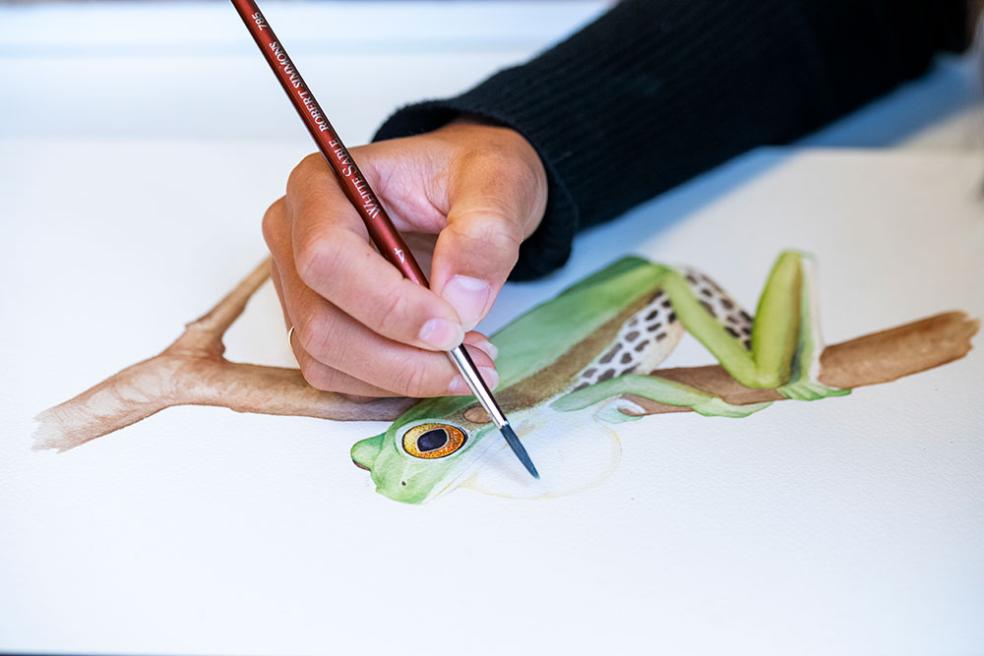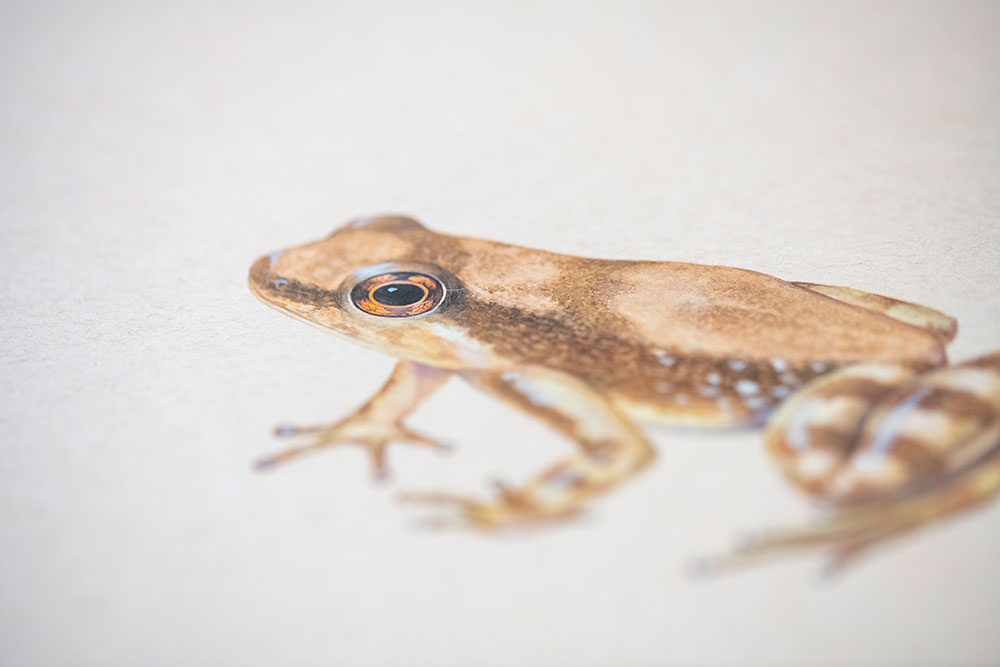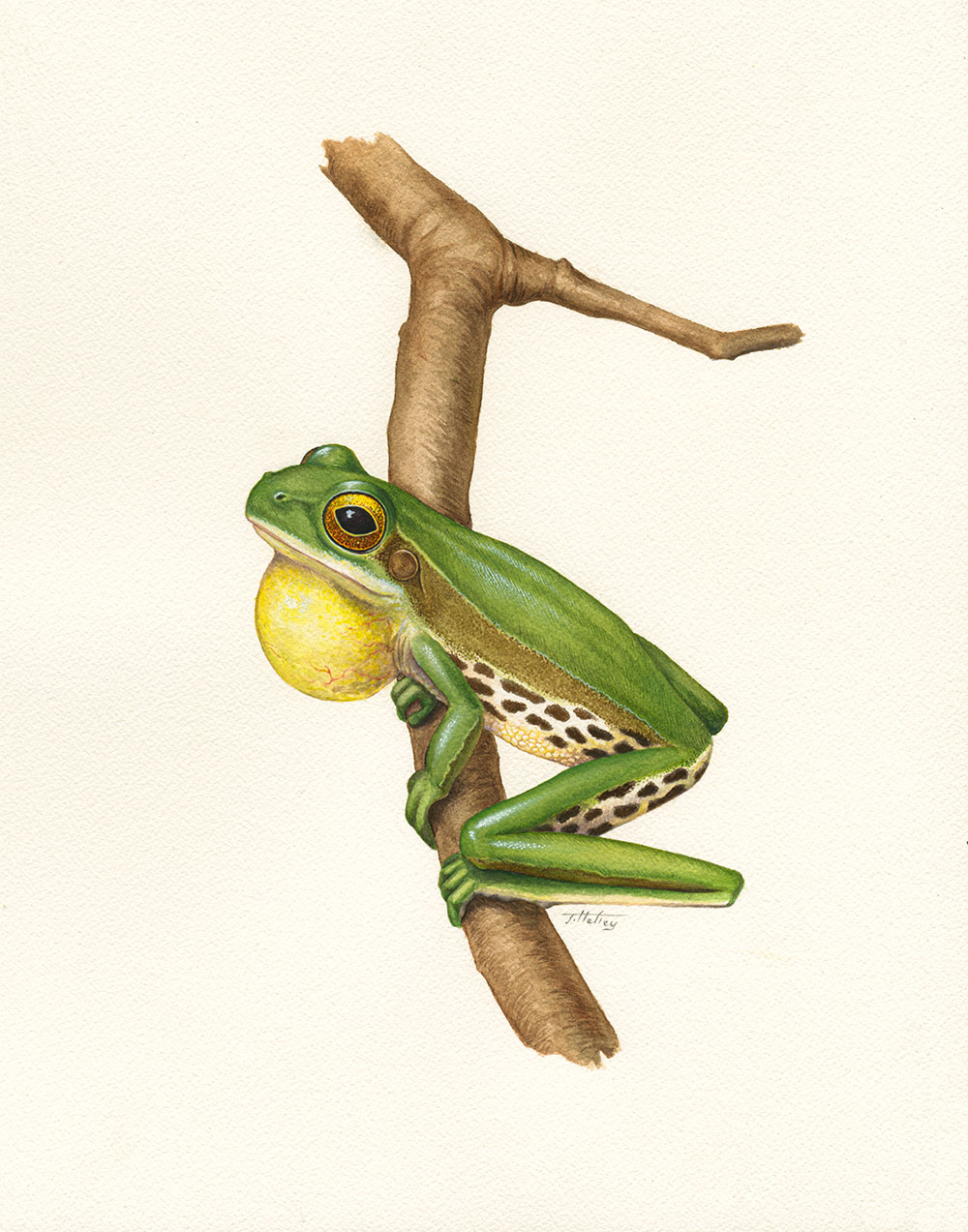
To further enhance knowledge of the natural world, Cal Poly Humboldt launched its scientific illustration internship this fall. The internship merges the University’s strengths in the liberal arts and sciences by inviting one intern to collaborate with faculty in the Biological Sciences and Art + Films departments for the duration of one semester. It is supported by a grant from the Maxwell-Hanrahan Foundation.
Scientific illustrator Jamie Hefley, a graduate of Iowa State University’s Biological and Pre-Medical Illustration program, joined Cal Poly Humboldt this October as the program’s first intern. She was chosen from a pool of highly-qualified candidates from five different countries.
Throughout the internship, she is focusing on bringing extinct species back to life by creating portraits of them. She works alongside professors Pedro Peloso (Biological Sciences) and Brandice Gonzalez-Guerra (Art + Film) to create illustrations of extinct Brazilian amphibians and, in turn, raise awareness about declining amphibian populations.
The internship is part of a groundbreaking project by Peloso that aims to resurrect the silent tales of frogs, salamanders and caecilians that have already vanished to raise awareness about the nearly 200 amphibian species at risk of disappearing forever.
The project, Documenting Threatened Species (DoTS), is a bold initiative to study, document and protect these threatened species through the creation of a database, and by bringing scientific knowledge to new audiences through lectures and activities in schools and communities.
"We are on a mission to breathe some life back into these lost amphibians. Through meticulous research and collaboration with artists, we aim to create modern, scientifically-accurate renderings of extinct or presumably extinct species from Brazil," says Peloso. He founded, directs and is the lead scientist of the project, which is supported by a large network of partners.
By creating the portraits, Hefley hopes to put a face to a much larger issue that extends beyond these individual species. “Although they belong to one of the most endangered animal groups globally, they remain largely overlooked,” Hefley says. “By creating portraits of these beautiful animals this earth stands to lose or has already lost, we hope to bring attention to the amphibians of our planet.”

Due to factors including habitat loss, emerging diseases, and climate change, amphibians are highly endangered, and some are already considered extinct, says Peloso, a Brazilian biologist who has specialized in amphibian conservation efforts for nearly 20 years.
“Amphibians stand apart from other animals as the most threatened of all—more than 40% of species listed are in threat categories,” says Peloso. “Brazil is the country with the most species of amphibians, many of which do not occur anywhere else on the planet.”
Some of the animals Hefley is illustrating are so rare that no photos of living specimens exist. So she turns to written descriptions, preserved specimens, and photographs of similar species to bring those species to life.
Accurately depicting key characteristics of these animals—anatomical features, measurements, proportions, and colors—requires diving deep into the scientific literature to learn about the minute details needed for realistic and artistically impactful illustrations.
"Some of these species are only known from a handful of specimens deposited in natural history collections, and have not been seen for several decades. Gathering information of how they might have looked in life is very challenging and highlights the importance of these collections, such as our Vertebrate Museum," explains Peloso.

Hefley’s passion for science and conservation runs as deep as her love of art. “I have always been captivated by science's branching, seemingly endless possibilities,” she says. “It is a dream to be able to pursue a career where I can continuously learn and explore the beauty and complexity of nature through another discipline I love: art.”
As part of the program, Hefley also works with students in Gonzalez-Guerra’s Illustration I course. Having her in the studio, says Gonzalez-Guerra, allows for organic interactions with students while they are working on their own illustrations.
“With the polytechnic transformation, we felt that this would be a good way to bridge those courses of study and provide students with the opportunity to interact with a professional scientific illustrator and witness the collaborative process that goes into creating a series of scientific illustrations,” says Gonzalez-Guerra.
The internship is not the only opportunity of its type available on campus; students can take Scientific Drawing I, a popular course on campus among science and art majors in which students create natural history drawings, Gonzalez-Guerra explains.
Hefley’s hope is that her creations will reach as many eyes as possible. “I see the potential for this project to educate and inspire, supplement research, evoke emotion, and raise awareness about the importance of conserving biodiversity.”
Art is a powerful tool, she says. “Through art, we can inspire a greater appreciation and understanding of the natural world and, in turn, encourage efforts to protect and conserve it.”
Hefley will display her work in a gallery exhibition on campus at the completion of this internship. Her illustrations may also be featured in scientific publications, and in exhibitions throughout the world including in South America. She will share her story and her work in an artist lecture on Friday, Dec. 1 from 2:30-3:30 p.m. in ART B 102. A Q&A will follow.
